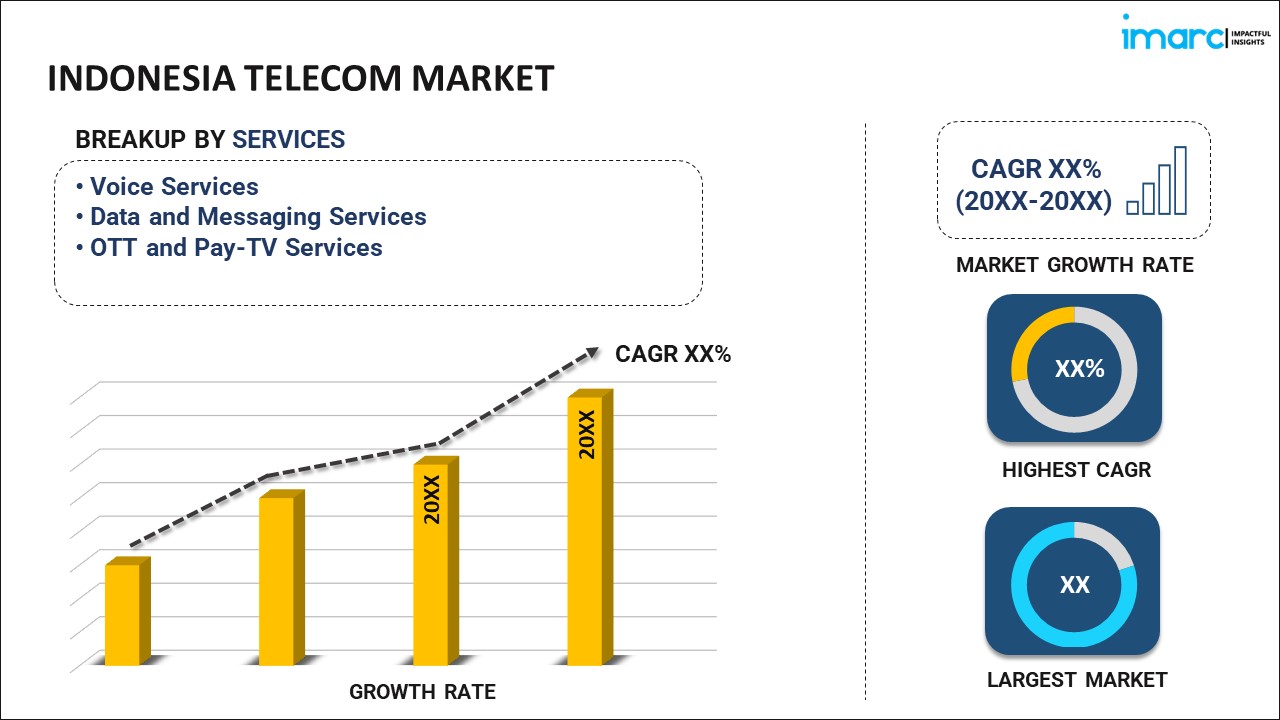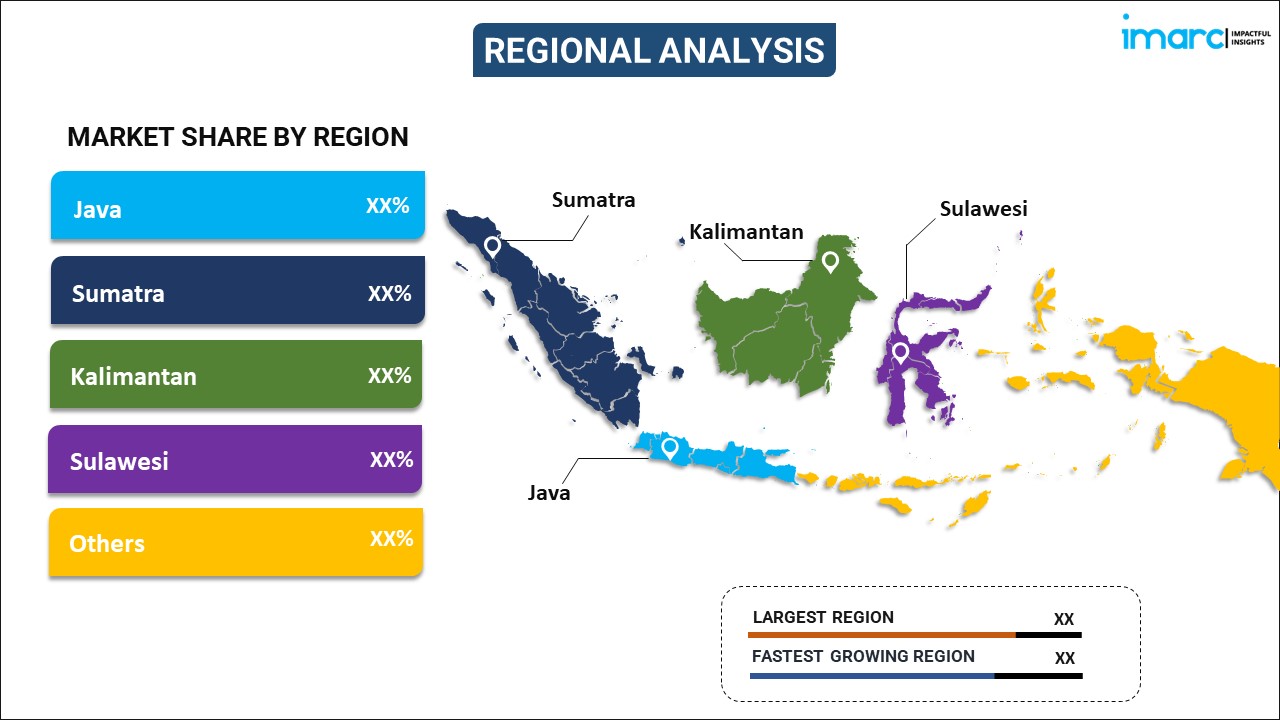
Indonesia Telecom Market Report by Services (Voice Services, Data and Messaging Services, OTT and Pay-TV Services), and Region 2024-2032
Market Overview:
Indonesia telecom market size is projected to exhibit a growth rate (CAGR) of 1.2% during 2024-2032. The deployment of 5G networks, the rise in mobile data consumption, the growth of IoT devices and applications, the rapid digital transformation, the escalating adoption of remote work, and the increasing affordability and availability of smartphones are some of the factors propelling the market.
|
Report Attribute
|
Key Statistics
|
|---|---|
|
Base Year
|
2023 |
|
Forecast Years
|
2024-2032
|
|
Historical Years
|
2018-2023
|
| Market Growth Rate (2024-2032) | 1.2% |
Telecommunications, often called "telecom," is a dynamic and multifaceted industry that transmits information, including voice, data, and multimedia content, over various platforms. At its core, telecom involves the exchange of signals and information between devices or individuals, utilizing a range of technologies such as wired and wireless networks, satellites, and optical fibers. The industry connects people globally, facilitating seamless communication and data transfer. Telecommunications services include voice calling, internet connectivity, and multimedia streaming, delivered through telecommunications networks operated by providers. As technology evolves, so does the telecom sector, with advancements like 5G networks, Internet of Things (IoT) connectivity, and digital communication tools shaping its landscape. Telecom is fundamental for personal communication and a critical backbone for businesses, governments, and various industries, enabling economic activities, innovation, and societal progress. As a result, telecom remains integral to fostering connectivity and enabling the exchange of information on a global scale.
Indonesia Telecom Market Trends:
The market is predominantly propelled by the rising adoption of smartphones and mobile devices among the population. Along with this, the widespread expansion of 4G networks has significantly enhanced connectivity across the country. Additionally, government initiatives aiming to bolster digital transformation have been crucial in establishing a conducive regulatory environment, thereby attracting investment in the sector. In line with this, the heightened focus on rural connectivity is creating new growth avenues, as telecom operators expand their services to previously underserved areas, thereby widening their consumer base. This expansion into rural areas not only enhances the market reach but also solidifies the overall growth trajectory of the telecommunications sector in Indonesia. The COVID-19 pandemic has also accelerated the necessity for high-speed and reliable internet, prompted by the growth in remote work and online education, thereby fueling the market. The market is also boosted by the increasing usage of digital services for various applications, ranging from online transactions to social media engagement. This growth in digital activities necessitates robust telecom infrastructure to handle the data traffic effectively. In addition to these factors, a competitive landscape populated by multiple telecom operators has been instrumental in fostering innovation and improving service quality. The market is further driven by the diverse range of digital communication platforms and services that have emerged, satisfying a growing consumer demand for resilient and efficient telecom infrastructure. Furthermore, the emergence of Internet of Things (IoT) technology is providing lucrative opportunities for telecom companies, as industries such as agriculture, healthcare, and manufacturing increasingly integrate IoT solutions that require strong network support.
Indonesia Telecom Market Segmentation:
IMARC Group provides an analysis of the key trends in each segment of the market, along with forecasts at the country level for 2024-2032. Our report has categorized the market based on services.
Services Insights:

- Voice Services
- Wired
- Wireless
- Data and Messaging Services
- OTT and Pay-TV Services
The report has provided a detailed breakup and analysis of the market based on the services. This includes voice services (wired and wireless), data and messaging services, and OTT and pay-TV services.
Regional Insights:

- Java
- Sumatra
- Kalimantan
- Sulawesi
- Others
The report has also provided a comprehensive analysis of all the major regional markets, which include Java, Sumatra, Kalimantan, Sulawesi, and Others.
Competitive Landscape:
The market research report has also provided a comprehensive analysis of the competitive landscape in the market. Competitive analysis such as market structure, key player positioning, top winning strategies, competitive dashboard, and company evaluation quadrant has been covered in the report. Also, detailed profiles of all major companies have been provided. Some of the key players include:
- PT Bakrie Telecom Tbk
- PT Elang Mahkota Teknologi Tbk
- PT Smartfren Telecom Tbk (Sinar Mas)
- PT Telkom Indonesia (Persero) Tbk
- PT XL Axiata Tbk (Axiata Group Berhad)
- PT. Indosat Tbk
(Please note that this is only a partial list of the key players, and the complete list is provided in the report.)
Indonesia Telecom Market Report Coverage:
| Report Features | Details |
|---|---|
| Base Year of the Analysis | 2023 |
| Historical Period | 2018-2023 |
| Forecast Period | 2024-2032 |
| Units | US$ Million |
| Scope of the Report | Exploration of Historical and Forecast Trends, Industry Catalysts and Challenges, Segment-Wise Historical and Predictive Market Assessment:
|
| Services Covered |
|
| Regions Covered | Java, Sumatra, Kalimantan, Sulawesi, Others |
| Companies Covered | PT Bakrie Telecom Tbk, PT Elang Mahkota Teknologi Tbk, PT Smartfren Telecom Tbk (Sinar Mas), PT Telkom Indonesia (Persero) Tbk, PT XL Axiata Tbk (Axiata Group Berhad), PT. Indosat Tbk, etc. (Please note that this is only a partial list of the key players, and the complete list is provided in the report.) |
| Customization Scope | 10% Free Customization |
| Report Price and Purchase Option | Single User License: US$ 3699 Five User License: US$ 4699 Corporate License: US$ 5699 |
| Post-Sale Analyst Support | 10-12 Weeks |
| Delivery Format | PDF and Excel through Email (We can also provide the editable version of the report in PPT/Word format on special request) |
Key Questions Answered in This Report:
- How has the Indonesia telecom market performed so far and how will it perform in the coming years?
- What has been the impact of COVID-19 on the Indonesia telecom market?
- What is the breakup of the Indonesia telecom market on the basis of services?
- What are the various stages in the value chain of the Indonesia telecom market?
- What are the key driving factors and challenges in the Indonesia telecom?
- What is the structure of the Indonesia telecom market and who are the key players?
- What is the degree of competition in the Indonesia telecom market?
Key Benefits for Stakeholders:
- IMARC’s industry report offers a comprehensive quantitative analysis of various market segments, historical and current market trends, market forecasts, and dynamics of the Indonesia telecom market from 2018-2032.
- The research report provides the latest information on the market drivers, challenges, and opportunities in the Indonesia telecom market.
- Porter's five forces analysis assist stakeholders in assessing the impact of new entrants, competitive rivalry, supplier power, buyer power, and the threat of substitution. It helps stakeholders to analyze the level of competition within the Indonesia telecom industry and its attractiveness.
- Competitive landscape allows stakeholders to understand their competitive environment and provides an insight into the current positions of key players in the market.
Need more help?
- Speak to our experienced analysts for insights on the current market scenarios.
- Include additional segments and countries to customize the report as per your requirement.
- Gain an unparalleled competitive advantage in your domain by understanding how to utilize the report and positively impacting your operations and revenue.
- For further assistance, please connect with our analysts.
 Inquire Before Buying
Inquire Before Buying
 Speak to an Analyst
Speak to an Analyst
 Request Brochure
Request Brochure
 Request Customization
Request Customization




.webp)




.webp)












